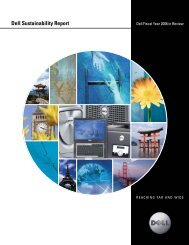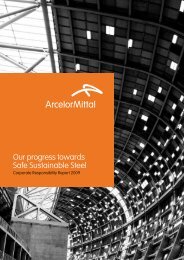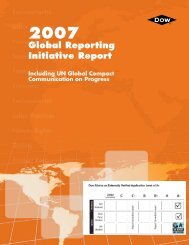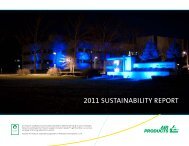English - The Clorox Company
English - The Clorox Company
English - The Clorox Company
You also want an ePaper? Increase the reach of your titles
YUMPU automatically turns print PDFs into web optimized ePapers that Google loves.
GHG Emissions by Gas Type (2009)<br />
CO 2 91 percent<br />
CH 4 1 percent<br />
N 20 7.5 percent<br />
HFCs 0.5 percent<br />
Other Gas Emissions and<br />
Particulate Matter<br />
In addition to GHG emissions, <strong>Clorox</strong> is<br />
committed to carefully monitoring and working<br />
to minimize other gas emissions and particulate matter.<br />
Our manufacturing processes use a minimal amount of<br />
fluorinated gases, primarily chlorodifluoromethane<br />
This gas is part of industrial refrigeration systems and<br />
works in a closed-loop system.<br />
PLANET<br />
GHG Emissions<br />
by Segment<br />
(’000 metric tons)<br />
600<br />
22<br />
51<br />
202<br />
14<br />
61<br />
250<br />
595<br />
22<br />
52<br />
198<br />
14<br />
61<br />
248<br />
561<br />
21<br />
48<br />
183<br />
14<br />
58<br />
236<br />
2007 2008 2009<br />
HOUSEHOLD<br />
CLEANING<br />
LIFESTYLE<br />
TRANSPORT<br />
INTERNATIONAL<br />
OFFICES<br />
While the <strong>Clorox</strong> GHG inventory has not been independently verified by<br />
a third party, our GHG inventory gathering process and calculations<br />
(for 2005-2009) were led and conducted by a third-party environmental<br />
services firm that has detailed knowledge of the operations and air<br />
emissions characteristics of the major <strong>Clorox</strong> manufacturing facilities<br />
and uses the methodologies and emissions factors from well-known<br />
GHG protocols, including those of the U.S. Department of Energy, World<br />
Resources Institute and EPA’s Climate Leaders.<br />
We also monitor the use and release of volatile organic<br />
compounds, particulate matter, sulfur oxides and<br />
nitrogen oxides. Our plants comply with air permits<br />
that limit these pollutants based on federal, state and<br />
local government regulations. We are actively looking<br />
for technologies and efficiencies to further reduce<br />
particulate matter emissions in the future.<br />
On Track to Achieve Our<br />
Water-Reduction Goal<br />
<strong>Clorox</strong> has made strong<br />
progress in reducing our<br />
water use in the past two<br />
years as a result of initiatives<br />
that addressed our water<br />
recycling infrastructure,<br />
upgraded equipment and<br />
replaced water-cooled with<br />
air-cooled compressor<br />
systems. Two of our<br />
Kingsford ® charcoal plants,<br />
for example, have each<br />
reduced water consumption<br />
by more than 30 percent.<br />
We believe these types<br />
Water Consumption<br />
1,029<br />
2.35<br />
960 952<br />
2.17 2.15<br />
2007 2008 2009<br />
CONSUMPTION<br />
(millions of gallons)<br />
RATIO<br />
(gallons of water per case)<br />
of initiatives, as well as<br />
changes to manufacturing<br />
facility water management<br />
practices, will enable us to<br />
meet or exceed our overall<br />
water-use reduction goal of 10 percent by 2013.<br />
By volume, most of the water consumed<br />
by <strong>Clorox</strong> is derived from city water utilities.<br />
A small fraction of our total water use is<br />
derived from surface and well water.<br />
<strong>The</strong> <strong>Clorox</strong> <strong>Company</strong> | 2010 CRR 45

















